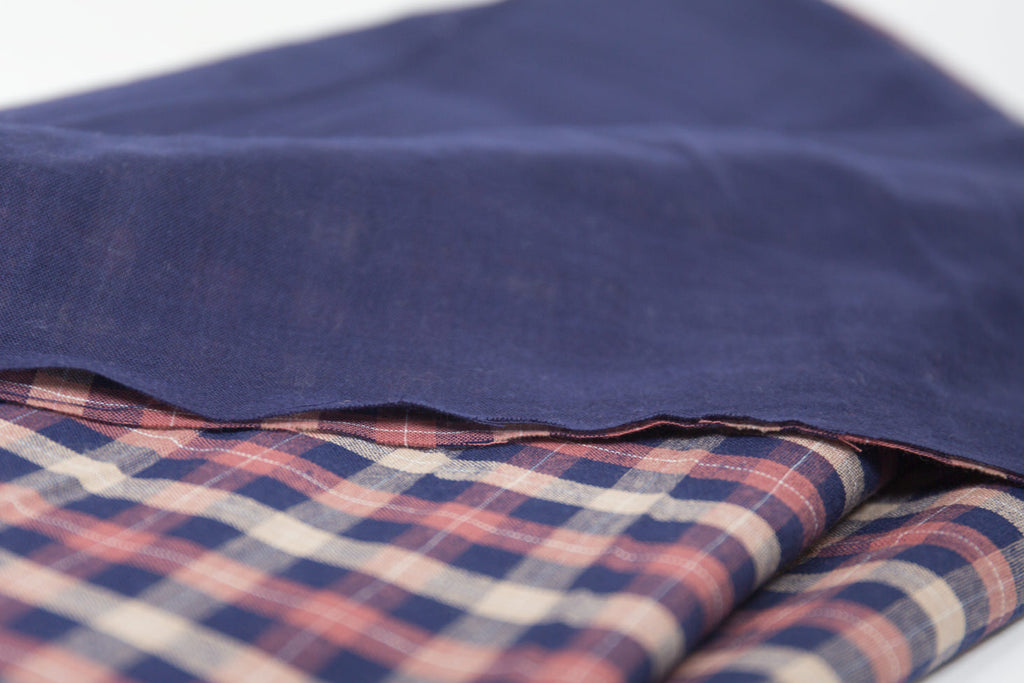Fabric Files: Double Cloth

This content was originally written for Indiesew and has been adapted for this blog. It was originally published on January 9, 2018.
Today’s Fabric Files post is long overdue. I sing this fabric’s praises on Instagram all the time, but it’s clear there’s still a bit of confusion about double cloth among the sewing community. I constantly hear questions like, “Is it the same as double gauze?”, “How does it wash and wear?”, and “Is it a good year-round fabric?”.
Let me just say this: double cloth is hands down one of the most versatile woven fabrics available. Let’s see why.
Double Cloth Characteristics
Broadly speaking, double cloth fabrics have two layers of fabric threaded or fused together to make one double sided fabric. This blog post will focus mainly on cotton double cloth.
It's important to note that double cloth is different from double-faced fabric. Double-faced fabrics are reversible, but consist of only one layer of fabric. For example, jacquard is a double-faced fabric, where the motif is woven into the fabric and is inverted on the opposite side.
Double cloth is two very lightweight, somewhat sheer, pieces of fabric stitched together to make a completely opaque textile. Both layers of fabric are more loosely woven than your standard one-layer woven fabric. The two pieces of fabric are connected with a single nearly invisible stitch sewn at regular intervals, usually about an inch apart.

Double cloth fabrics are often plaid fabrics with a solid or plaid opposite side. This Navy and Rose Plaid Double Cloth (above) has a solid navy backing, while the Navy and Red Plaid and Navy and White Plaid Double Cloths (below) feature two different plaids designs.

Double cloth is typically 100% cotton. It ranges anywhere from 45" to over 60” wide and weighs 3 to 5 ounces per square yard. It’s a breathable fabric that looks great sewn up into tops and dresses.
Double cloth is also very similar in hand to and is manufactured just like double gauze. When washed, the cotton fibers of double cloth expand and soften giving the fabric a worn-in look.
How to Sew with Double Cloth
One reason we love double cloth so much is that it's a relatively stable fabric, well suited for the beginner sewist with some sewing experience. While not as stable as quilting cotton or other bottom weight fabrics, double cloth doesn’t tend to have the shape shifting tendencies that fabrics like rayon challis or silk crepe do.
Because each layer of double cloth is loosely woven, you are likely to see the edges of your fabric fray considerably while sewing. Because of this "fray factor", it is highly recommended that you serge or French seam the seam allowances of your double cloth garments.
Since double cloth is reversible, it’s a great fabric to use for contrasting pattern play. Use the wrong side of the fabric to add contrast to garments without having to buy extra yardage of a contrasting fabric!
Better yet, you can make your double cloth garments fully reversible by sewing with flat-felled seams.
How to Care for Double Cloth
Perhaps the most signature characteristic of double cloth is how it softens after being washed and dried. Straight from the bolt you’ll notice that double cloth is a bit stiff to the touch. This is due to the starch (called sizing) applied to the fabric in the manufacturing process.
But once pre-washed and the sizing is rinsed away, double cloth fibers expand and soften, giving the fabric a soft and squishy feel. The fabric instantly has a worn-in look. Like double gauze, after it's washed double cloth doesn’t always press crisp like a cotton shirting, a worn-in, slightly wrinkled look will always accompany this fabric.
In the photo below the fabric bolt on the bottom has not been washed and the fabric on top has.

After sewn, your double cloth garments should be washed on cold and line dried only to extend the wearable life
How to Buy Double Cloth
There isn’t much double cloth fabric on the market, so you may not immediately know whether a double cloth is good quality. We recommend buying cotton double cloth fabric because it’s a breathable textile, making it ideal for year-round wear.
If one layer of double cloth fabric is slightly see-through, don’t immediately discount it as poor-quality fabric. On the bolt, the layers of double cloth can be somewhat sheer. But once washed, the fibers tend to fill in and make the fabric opaque.
Cotton double cloth typically ranges from $12 to $18 per yard.
Garments Best Suited for Double Cloth
My go-to double cloth garment is a button up shirt or shirtdress. But other woven garments look great in double cloth too! Simple tank tops are great designs for this type of fabric. The Coram Top and Dress would look great sewn in double cloth fabric.
Have you had a chance to sew with double cloth? If not, I encourage you to give this versatile fabric a try! Start with a tried and true sewing pattern and you'll see that this two sided fabric gives you a multitude of options.
Happy sewing!



